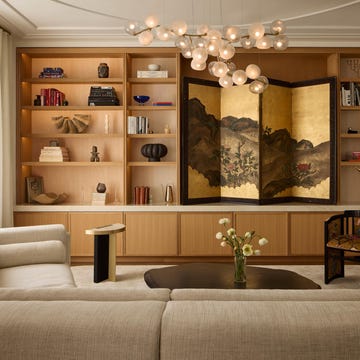One unforgettable summer on the Italian peninsula, nine-year-old Rudy Faissal told his parents that, one day, he would move to Italy. Fascinated by the country’s rich, multi-layered beauty, the Beirut-born Rudy followed through on that promise nine years later, moving to Venice to study architecture and then finding work in Milan.
What was meant to be ‘just another couple of years’ quickly turned into 15, during which he co-founded Lit Studio – a cutting-edge architectural practice that fuses Lebanese and Italian aesthetics – with Riccardo Boccia. The result is an eclectic mix of styles viewed through a contemporary lens, as reflected in his new home.
The apartment is located in a 1930s building in Milan, once owned by the Italian State Railways and constructed around the same time as the neighbouring Central Station, an imposing example of fascist-era architecture. It had original window frames and generous ceiling heights, but a less desirable layout, with a long corridor running along one side to connect four rooms. Rudy knocked down the walls and brought a spacious living area to the centre, flanked by two en-suite bedrooms.
What's everyone reading?
Then, he did what he does best. ‘To gain space, I placed the kitchen in an aluminium box and introduced it in what was the corridor. So we have a very Milanese apartment with this alien entity,’ he explains. Adding ‘a flaw element’ to play up the edginess is very much part of his signature style – here, an almost futuristic volume is set against a backdrop of old-world glamour.
The kitchen’s beautiful travertine floor extends beyond the aluminium box, subtly retracing the former corridor in a respectful nod to its past. The combination of red, beige and dark-brown stone is a custom design by Rudy, as is the unique pattern of the parquet planks. ‘This attention to detail in the flooring speaks to my Lebanese heritage and my appreciation for mosaics. I love mixing simple shapes and different materials to create interesting patterns and contrasts,’ he says.
One large sliding door provides an open feeling in the kitchen, but it can be closed when cooking. The light-burrwood cabinets blend harmoniously with the travertine counter, in the same shade as the beige floor but kicked up a notch by filling the holes with fluorescent-orange resin – ‘to give it a bit of a glow and not have everything ton sur ton’, Rudy adds.
While work on the shell was mainly aimed at preserving the 1930s spirit, a decidedly contemporary approach was embraced in the furnishing, with most pieces coming from Rudy’s personal collection or that of Lit Studio.
In the living room, ‘Sit/Lit’ – a modular armchair – was born from the firm’s collaboration with the Belgian designer Roxane Lahidji, while the sculptural dining table, one of Rudy’s favourite designs, is ingeniously made from slabs of marble. ‘It can be assembled and disassembled very quickly, a bit like a piece of Ikea furniture, but high-end. Being an architect and designer, as opposed to an artist, means that I enjoy creating shapes by assembling rather than carving,’ he explains.
This is Rudy’s third home in Milan; each has been slightly larger than the last. ‘At first, I worried that I would feel nostalgic about selling my previous apartment, but I didn’t develop an emotional attachment at all. Quite the opposite! I enjoy reimagining a whole new space and, when the time comes, replacing it with something bigger.’ litstudio.it



















